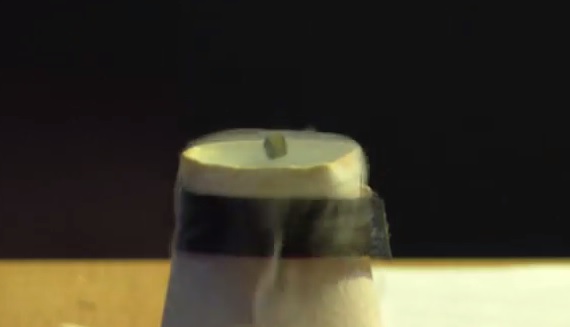How'd He Do That? Physicist Demos Quantum Levitation

A tiny cube floating and flipping in midair sounds like something straight out of "Harry Potter," but Harvard physicist Subir Sachdev doesn't need magic to levitate objects.
Sachdev performed a levitation demonstration using a magnet and a superconductor during a presentation at the Perimeter Institute on Oct. 1. Superconductors are incredible materials that can conduct electricity with zero resistance. But to generate the superconductivity, the material has to be extremely cold, and so Sachdev poured liquid nitrogen that's about minus 320 degrees Fahrenheit (minus 195 degrees Celsius) on the superconductor to trigger its superconductive state.
"One of the key properties of superconductors is that it hates magnetic fields," Sachdev said during his levitation demonstration. And so as the superconductor "repels" the magnet, the magnetic cube is lifted into the air. The magnet will fall after the superconductor begins to warm up again.
But superconductors aren't just for levitation demonstrations, Sachdev said. [The Cool Physics of 7 Classic Toys]
"The hope is that these materials will actually be useful for something," Sachdev said.
High-temperature superconductors could have a wide variety of applications, including in MRI machines, motors, generators, fusion reactors and low-loss power cables.
Quantum mechanics 101
Sign up for the Live Science daily newsletter now
Get the world’s most fascinating discoveries delivered straight to your inbox.
Physicists are still not entirely sure what gives a superconductor its magiclike properties and why superconductivity doesn't work above a certain temperature, but Sachdev said he thinks he's pretty close to the answer.
But to understand how a superconductor works, "you need to know some quantum mechanics basics," Sachdev said after his levitation demonstration. The main idea of quantum mechanics is that an object like an electron or a photon behaves as both a particle and a wave, Sachdev said.
"That's one of the key mysterious properties of quantum mechanics," Sachdev said.
The other weird characteristic of quantum particles is that they can exist in multiple places at once, a phenomenon called superposition. But superposition is a fragile state. The moment that scientists try to measure the particles, the superposition state collapses and the particles come to exist in only one spot. Before the particles are disturbed, they exist in multiple places all at once, and "yeah, you just have to accept it," Sachdev joked during his presentation.
Quantum entanglement
Quantum entanglement is superposition on a larger scale, something that Sachdev described during his talk. Particles become entangled when they interact with each other. Entanglement means that when an action is performed on one particle, it directly affects that particle's entangled partner no matter how far apart they are. [How Quantum Entanglement Works (Infographic)]
Sachdev said a good way to think about this is to imagine how two entangled electrons rotate. Electrons either rotate clockwise (an "up" spin) or counterclockwise (a "down" spin).
"Is the left electron up or down?" Sachdev asked the audience. "The answer is really both." And this is true for both electrons.
The electrons will stay in this superposition state until someone measures one of the two particles. If one electron has an up spin upon being measured, its entangled partner instantaneously acquires a down spin. This is true no matter how far apart the electrons are, even if one electron stayed on Earth and the other was beamed to the moon.
Sachdev said he thinks a special kind of this quantum entanglement is responsible for the magiclike properties of superconductors.
A crystalline compound called YBCO (yttrium barium copper oxide) is the first material that scientists discovered that can act as superconductor at temperatures above the boiling point of liquid nitrogen (minus 320 degrees Fahrenheit). Sachdev said the copper atoms in this substance are the most important part of the compound. The electrons around the copper atoms pair off, and "every pair of electrons is everywhere [in the material] at the same time," Sachdev said while showing a diagram of the paired electrons. This clump of entangled particles in superposition leads to superconductivity.
The quantum entanglement in a superconductor is a little more complex, Sachdev said. It appears the electron pairs swap partners, creating what he calls "long-range entanglement."
Learning more about long-range entanglement, Sachdev explained, will lead to better high-temperature superconductors. The basic technology already exists, but other obstacles prevent high-temperature superconductors from being used on a large scale. For example, using superconductors as power lines would require a huge startup cost, Sachdev said.
"Just think about replacing all the power cables under New York," Sachdev said.
Follow Kelly Dickerson on Twitter. Follow us @livescience, Facebook &Google+. Original article on Live Science.










